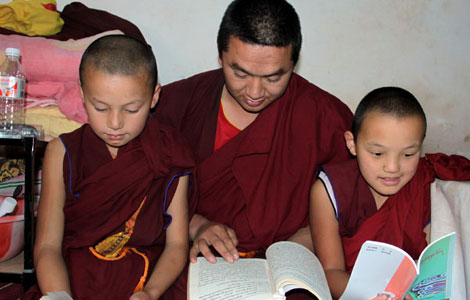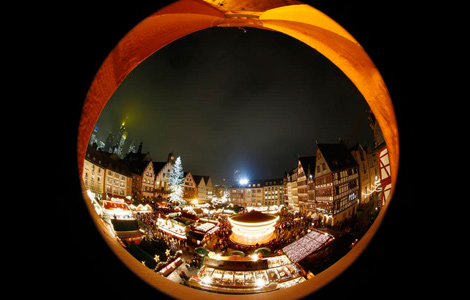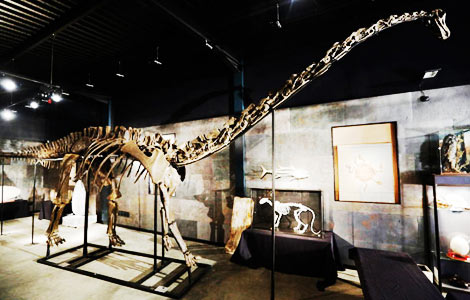Martyrs and marauders of Chinese history
Updated: 2013-11-29 04:44
By KELLY CHUNG DAWSON in New York (China Daily USA)
|
||||||||
In the late 1890s, against a backdrop of economic discord and growing Western influence, a group of Chinese peasants formed The Society of the Righteous and Harmonious Fists, later known as the Boxers. Believing their martial arts provided spiritual protection from European bullets, thousands marched into Beijing and managed to kill 30,000 Chinese Christians before discovering their powers to be useless in the face of an alliance of armed Western and Chinese soldiers. In the years following, the Boxers were alternately cast as idiots and heroes; today, they are mostly remembered for standing up against foreigners who sought to carve out influence using both religion and a thriving opium trade at a time when the Qing Dynasty was weakening.
For Gene Luen Yang, a graphic novelist and Catholic Chinese American, the legacy of the Boxers presented an illustration of the ambiguity faced by people who claim more than one cultural identity. In Boxers & Saints, a new two-part graphic novel recently announced as a finalist for the National Book Award, Yang tackles the complexities of Chinese history in dual coming-of-age stories that question what makes anyone a "good guy" or otherwise.
"Even now, when I look at the Boxer Rebellion, I have a hard time picking out the good guys and bad guys," Yang said. "I started out thinking I'd tell the story of the Chinese Catholic community, but the more I learned about the Boxers the more I found them fascinating. People on both sides were brave in the face of death, with motivations that feel incredibly understandable to me."
Yang, whose 2007 graphic novel American Born Chinese won a Printz Award, notes that many of the men who converted to Christianity in those years did so to avoid legal punishment for criminal activity. According to the unofficial rules of the time, Christians were subject to a different set of laws sanctioned by the Church. Other converts were simply outsiders, like Yang's Four Girl, the young female protagonist at the heart of Saints. Little Bao, the boy whose story is told in Boxers, is also a misfit. Although the two cross paths only twice, their stories are deeply intertwined.
Four Girl is visited by the spirit of Joan of Arc, whose inclusion is clearly intended to represent a parallel for the Boxers, who like the French heroine truly believed themselves to be fighting to save their country from foreign powers.
In mirroring scenes in each story line, spiritual figures are depicted in similar imagery inspired by a painting Yang once saw at the Asian Art Museum in San Francisco. In that painting, Guan Yin, the Chinese Goddess of Compassion, is surrounded by hands, each bearing an eye. He was struck by the similarities to Christian imagery depicting Christ's bleeding hands, and later learned that hands also appear in Judaism and Islam as symbols of compassion.
"There are strands of that compassion running through the stories of every culture," Yang said. "One side contains a piece of the other, always. No human being is purely evil or purely good."
In both books, Western characters speak in an illegible font meant to represent the manner in which Chinese viewed outsiders at the time, Yang said. Although they're initially presented to the reader in the same two-dimensional fashion, the Western characters are gradually revealed to be as human as their Chinese counterparts. A priest arrives in China expecting the natives to be entirely pure, and is saddened to find that they are equally flawed. In Yang's world, no one remains entirely unscathed.
As a Chinese American, the tension of cultural conflict has long been a source of creativity, Yang said. Children of immigrants grow up dealing with a constant negotiation of cultures, often using one name at home and another at school. For Chinese Christians, a third name might be used at church.
For non-Chinese readers, Boxers & Saints is intended to present a part of Chinese history that is rarely studied in depth in Western classrooms.
"Modern China is still dealing with the ramifications of what it believes to be a century of humiliation at the hands of Westerners," Yang said. "As China continues to grow stronger and as the relationship evolves, I think we'll see more importance ascribed to Chinese history. I hope that the books will inspire readers to pause and really take a look at both sides in any conflict."
kdawson@chinadailyusa.com
Most Viewed
Editor's Picks

|

|

|

|

|

|
Today's Top News
Air zone 'not aimed at civilian flights'
Pacts to boost economic co-op
Holiday plans stir up complaints
Industrial sector's profits rise in Oct
IAEA team continues review of Fukushima plant
Sugar imports soar in China
Italy Senate expels Berlusconi from parliament
Obama calls Saudi king over Iran: White House
US Weekly

|

|













